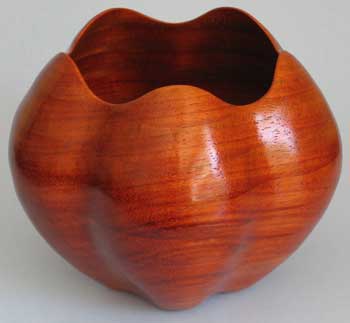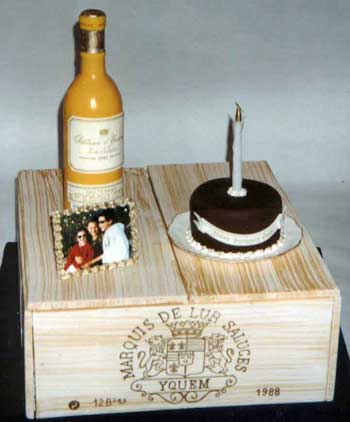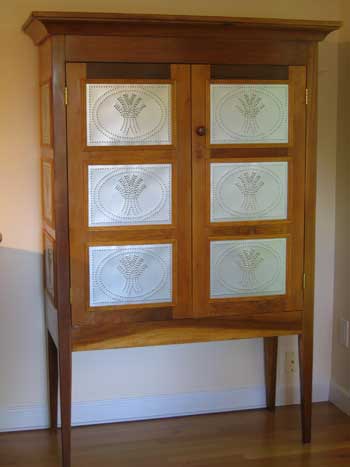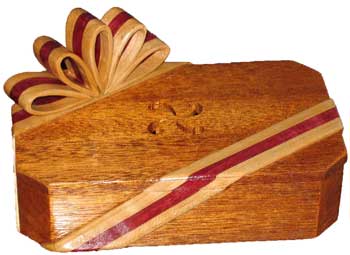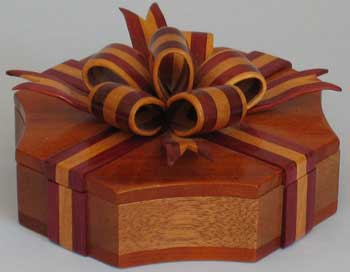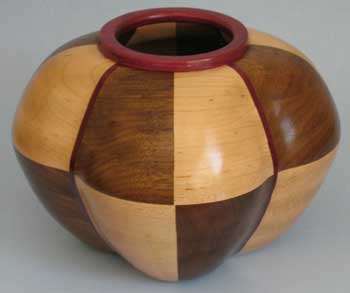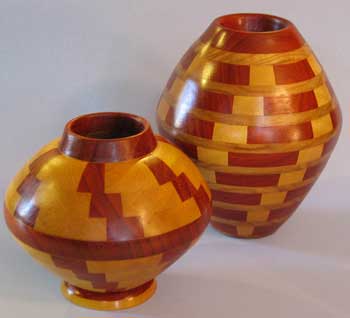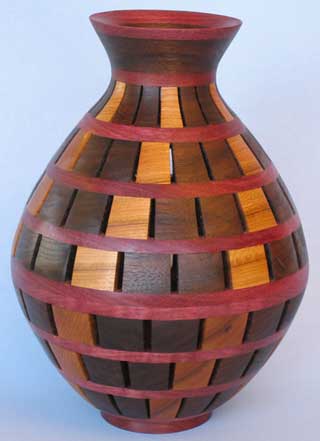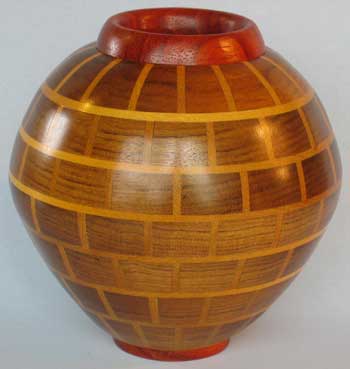
When she first began woodworking in earnest, Carole Rothman used skills honed on the sewing machine to control the band saw — but it’s her scroll saw work that she hopes creates a new genre in woodworking.
Although Carole has been involved in working with her hands since childhood, it didn’t come from any family influence. Her family are teachers and academics — “my father would call an electrician to change the lightbulb.” By age eight, she had learned to knit and crochet from her mother, but when they bought a sewing machine and learned to sew together, Carole quickly surpassed her mother’s skills, sewing her own clothes by age nine.
As a young married woman (she designed and sewed her own wedding dress), Carole encountered a situation familiar to many: “We didn’t have much money — we were pretty strapped.” She began refinishing furniture for her new abode, because it was less costly than buying new. “Oak was in, in those days,” Carole said. She learned about oak and other woods — “how it worked, how it finished” — from an antique dealer.
When her young family moved on to a 50-year-old Tudor style home, Carole began learning a new set of skills, in carpentry, plumbing, heating and more home improvement. “We built a deck; we replaced doors….,” she said. “I learned to find my way around a lumberyard,” and, also, “I learned to deal with contempt. I once had a man in a hardware store ask me why I wasn’t home making soup.”
Enough reticence regarding the male-dominated aspect of woodworking remained that it took Carole over a year to join the woodworking club which is part of the condo unit where she and her partner live. Carole, divorced from the husband of her younger days, had wanted her partner to make a collapsible wooden basket but, after a year in which he hadn’t made the project, she decided to do it herself. As she made the basket on the band saw, she discovered, “It was not a big deal. The skills I’d developed on the sewing machine gave me control.”
As she continued to work on the band saw, other people in the shop began noticing her work and asked Carole, who has 32 years of experience teaching at the college level, to teach a class on band saw basics to publicize the shop. The class was approaching, and “it was around this time that the band saw went badly out of alignment. I was going to be teaching new people, and I was afraid for their fingers. I needed a backup plan.”
The shop had a scroll saw, but “it was a pin type, that was a piece of junk when it was donated,” Carole said. She characterized the attitude of the other shop members as, “It’s a scroll saw, what do we need another one for?” After convincing them to buy a more modern scroll saw, Carole used an introduction to the scroll saw book by John Nelson to teach herself about the tool. Self-taught in other areas, she learned how to use the tool, successfully taught the class — and began moving her own scroll saw work from baskets to boxes.
The boxes incorporated techniques honed from another of Carole’s crafts: cake decorating. “I’d always been interested in cake decorating,” she said, and at one point, submitted a picture of one of her cakes to a contest, won a prize, and began an extensive contribution to a cake decorating magazine. She developed her own style in cake decorating, with a particular interest in “recreating edible objects that looked real. When those objects were meant to reflect wooden items, she used wood graining tools in her sugar paste, and mixed wood grain alcohol and shellac flakes to create the look of finished wood, “that was completely edible.” These cake projects — such as a cake shaped like a wooden wine crate — trained her eye to see how things were constructed, Carole said.
The first piece of furniture she built was a pie safe with pierced tin panels to act as storage for her cakes and cake decorating supplies– and, when she began scroll sawing in earnest, she brought her cake decorating skills and patterns to the new medium. A box she made in imitation of a cake decorated with gift-wrap bows won third prize in a woodworking contest judged by Frank Klausz.
“As I moved on, I discovered scroll saw bowls,” Carole said. She had liked the look of lathe-turned bowls, but “I was put off by the tremendous waste; you just leave shavings on the floor.” She found a book by Patrick Spielman on scroll saw bowls, but the construction methods relied heavily on the router, and she felt the level of instruction was too high for a beginner.
“I don’t like using other people’s patterns,”Carole said, and so, as in other areas she’d explored, she made her own, cutting up wood to see what would happen and using her background in sewing and understanding of fabric construction to recreate, in wood, patterns such as ginghams and plaids.
As she made more bowls using the scroll saw and sanding tools, Carole soon found herself with her own book contract. Wooden Bowls from the Scroll Saw, published by FoxChapel [ISBN 978978-1-56523-433-8], is “the book I needed when I started out,” Carole said. It’s also the book she hopes will launch scrollsawn bowls as a new genre in scroll saw woodwork, along with such items as fretwork puzzles.
The scroll saw, she said, is a very safe tool that can serve to demystify woodworking to a larger audience, and is also “economical with wood. It’s a wonderful craft for our times. It’s a wonderful way to make beautiful things without them being a big deal.”
Now that her first scroll saw book has been put to bed, Carole herself has been experimenting with open segmented bowls, different laminations and colors. She gets those colors from natural woods such as padauk, yellowheart and purpleheart, finished with clear finishes. “I’m now able to do things I couldn’t do when I started out, because I didn’t have the woodworking skills.”
Some of her newer bowls defy understanding, she said, and actually could not be made on the lathe. “When you do something that no one has done before and are entirely self-taught, someone doesn’t say ‘you can’t do that,’ so you don’t know you can’t do that,” she said. “What I’m after is to make beautiful projects.”
